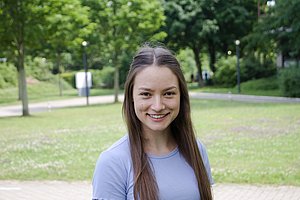Photosynthesis as Blueprint
In light-harvesting machineries, such as those found in phototrophic bacteria or green plants, incident photons (light particles) are captured by a large number of antenna chromophores. The latter are specific dyes which funnel the energy in multiple steps with minimal loss to the reaction center. Here, electron transfer occurs between a special pair of chromophores. The electrons are further passed down the transport chain for driving the formation of ATP - a high energy molecule which can be regarded as the cellular energy currency. Natural light harvesting occurs with near quantum efficiency, meaning that almost every photon contributes to the generation of a charge separated state. The high efficiency of natural light harvesting relies on the specific spatial arrangement of the chromophores, i.e. their relative orientation and distance. In contrast, state-of-the-art photovoltaic devices reach efficiencies of up to approximately 25%.
Dye-Based Coordination Cages
For getting insight into artificial light harvesting, chemists are studying light-driven processes in synthetic multi-chromophore systems. The latter are most often constructed through classical multi-step synthesis. While this approach ensures control over the inter-chromophore distances, it is usually resource- and time-consuming. A more efficient way for organizing numerous building blocks is the molecular self-assembly. Here, different components with pre-programmed connectivity are pooled together and organize to a larger, defined structure. Reversible interactions between the building blocks allow for “error-correction” and hence for yielding the energetically most favored final arrangement. A subclass of self-assemblies are coordination cages consisting of organic ligands, which are compounds with metal-binding parts, and metal ions - in our case palladium(II) (Pd(II)). Cages are discrete entities that can be processed and studied in solution. The most simple cage is composed of two Pd(II) ions bridged by four organic ligands and possesses overall the shape of a lantern. By employing organic ligands that are based on chromophores, multiple of the latter are brought in close proximity and are arranged in a specific manner. This can alter the properties of the dyes and can lead to the emergence of phenomena which are not observed in the isolated chromophores. Recently, we showed that the number of dyes which were stacked within the assembly allows for tuning the assemblies’ absorption and fluorescence (spontaneous emission of light) properties.1 We also use the cages as a platform for studying complex light-driven processes such as those observed in the photosynthetic apparatus.
Electron Transfer Phenomena in Cages
For creating cages capable of undergoing photo-induced charge separation, two different kinds of ligands - an electron donor (D) and an electron acceptor (A) ligand - have to be combined within one cage. From a statistical point of view, the most probable self-assembly outcome by combining the building blocks is a combinatorial library of cages in which donor and acceptor ligands adopt arbitrary positions.2 For circumventing the formation of such a statistical mixture, our group developed strategies for controlling the self-assembly outcome. In my work, such a strategy3 is applied for synthesizing a library of donor-acceptor cages with defined stoichiometry and stereochemistry. Donor and acceptor chromophores are systematically exchanged, i.e. the cages differ either in their donor or their acceptor ligand. In further steps, we are investigating the electron transfer properties. On one hand, we gain insight into how “easy” (from an energetical perspective) an electron is transferred between the donor and acceptor moieties. On the other hand, we are interested in the rate at which these processes occur. While the former can be well estimated when designing the cage, the latter is still unpredictable for these systems. The soluble character of the cages allows to study solvent effects on the excited state properties and charge transfer rates. Owing to the ultrafast time scales at which photo-induced electron transfer occurs, a sophisticated technique, namely pump-probe spectroscopy is required for following these processes. To put it in simple terms, a first laser pulse excites the chromophores (hence taking on the role of the sunlight) and a second pulse interrogates the thereby caused changes in the system in a time-resolved manner. In the course of a RESOLV-funded internship in the group of Prof. Schlau-Cohen at Massachusetts Institute of Technology, a range of donor-acceptor cages have been investigated by applying this technique. Further measurements were carried out in collaboration with the group of Prof. Havenith-Newen at Elettra Synchrotrone Trieste. Having in hand the kinetic parameters for electron transfer in combination with the energetic driving force and the molecular structure will, due to the systematic approach, allow us to draw structure-property relationships. By investigating these relationships, we aim at contributing to the design of artificial light-harvesting systems with tailored properties.
We are currently working on the modification of donor acceptor cages with solubility controlling groups. This allows aggregation4 of photo-redox active cages into higher-ordered structures such as vesicles. In contrast to the randomly oriented cages in solution, such an arrangement holds promise for achieving directional electron transfer. Furthermore, the inner and outer solvent environments of such materials can be tuned selectively.
[1] Angew. Chem. Int. Ed. 2023, e202308288. https://doi.org/10.1002/anie.202308288
[2] J. Am. Chem. Soc. 2016, 138, 8279. https://doi.org/10.1021/jacs.6b04609
[3] J. Am. Chem. Soc. 2016, 138, 13750. https://doi.org/10.1021/jacs.6b08694
[4] J. Am. Chem. Soc. 2018, 140, 17384. https://doi.org/10.1021/jacs.8b10991
-----------------------------------------------------
About the author




